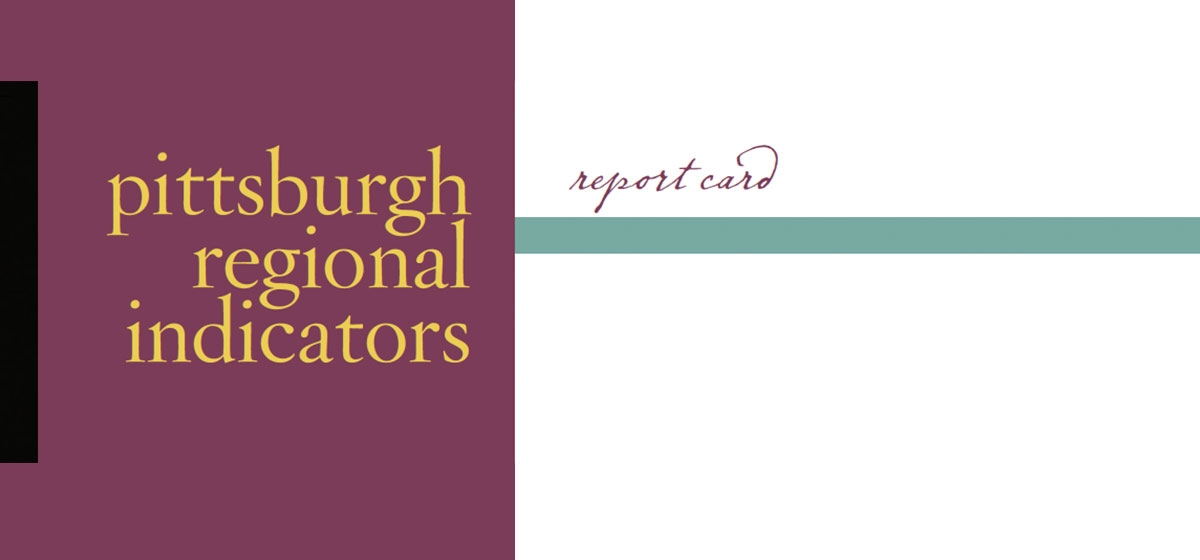
Time flies even when you are not always having fun. That’s the lesson I take away from 18 months publishing indicators on pittsburghtoday.org and writing about them in this space. My ambivalence is a product of pride that we have developed a regional information system that can serve us well if we expand and sustain it, as well as discomfort at being the bearer of a disproportionate amount of negative data about this region.
That statement may come as a surprise if you are addicted to stereotypes, but reporters take no pleasure in “bad” news. Their satisfaction comes from uncovering the truth and telling people about it. But when there is so much about the Pittsburgh region to give the sensitive citizen pause, as there most certainly is, you find yourself worrying, to quote Mary Poppins, about the best way to lay your hands on a little sugar “to make the medicine go down.” How to keep people engaged when a great deal of what you have to report is so discouraging?
This is my quandary on the eve of a major push to call attention to pittsburghtoday and develop a community network of support and involvement. I have some tentative conclusions that I’d like to try out on you, using indicator information that is new and in some cases not yet published by www.pittsburghtoday.org. My first caveat concerns rankings. Take a look at Figure 1 and Figure 2. They, respectively, present data on start-up businesses and venture capital. In the first instance Pittsburgh is next to last and in the second, 6th of the 15 benchmark cities. (Figure 2 is a composite of both the number of venture capital deals in the last 12 months and their total dollar value.)
When you see those two rankings, are you encouraged or discouraged? Obviously your immediate answer is that you will need a bit more information before giving an intelligent answer. If you are like me, you resent seeing such subjects addressed in isolation. You want them analyzed as part of a more comprehensive report. In this instance, start-ups and venture capital are being gathered as markers of “business vitality” by our Economic Committee. It has been measuring jobs and wages as the two key regional economic indicators since the beginning of the project but decided recently that vitality was relevant to putting jobs and wage rates in better context.
When it comes to jobs, Figure 3 indicates Pittsburgh is adding jobs at a higher rate than it has for several years. The region still lags all but four benchmark regions and average job growth rate trails the nation, but Pittsburgh’s number is heading in a positive direction; a year ago only two cities were performing more slowly, today there are four. Therefore, rank as you must, but be at pains to explain each ranking’s significance in relation to the whole.
My second caution follows immediately. Using national rankings as your primary context often adds no insight and can be misleading — particularly without adequate comment about relevance. It was recently reported in the press that western Pennsylvania is home to four of the nation’s “dirtiest” electrical power plants. According to the Environmental Integrity Project, a Washington nonprofit that seeks better enforcement of anti-pollution law, the Bruce Mansfield plant in Shippingport was 17th highest (as in the “worst”) of the nation’s top 50 plants, with 17.3 million tons of greenhouse gas emitted in 2006. Three other plants in this area were 29th, 42nd and 43rd in carbon dioxide output; there are 378 plants in the nation on which statistics are kept.
That sounded bad, but was it significant? And should we care that Indiana is also home to four of the dirtiest plants or that Texas led all states with five of the top 50? I can see no good reason. Though non-compliance and inadequate use of technology are important factors in these rankings, there is a heavy bias against size because what is being measured by the special interest group is total carbon dioxide releases during the year, not efficient operation. What should matter to this region is whether plants within its control are not only meeting the law but also employing the best technology and performing at the cleanest level possible. And even more important, what is the overall quality of the region’s air?
My next two indicators go directly to these points. They also serve to introduce another caution: Be sure you have comprehensive data. For example, the conventional wisdom in Pittsburgh holds that the Clairton Coke Works and fossil fuel-burning west and southwest of Pittsburgh are the major contributors to the region’s air problems. Under the rules of the Clean Air Act, regions are judged on the worst air quality reading over a 12-month period by any of their monitors. Last year, because of readings at the Liberty monitor near Clairton, one of 10 in the region, Pittsburgh was in its accustomed place at the top of the national list of regions with the highest readings of fine particulates — called PM 2.5. Particulates are one of six contaminants measured by law and along with ozone are considered significant indicators of bad air; fine particulates are 2.5 micrometers in diameter, thus the name.
However, the notion that the region’s air problem is solely a Clairton problem is much too simplistic as Figure 4 makes clear. Only Charlotte of benchmark cities had a higher reading of PM 2.5 in 2006 than Pittsburgh when average daily readings as opposed to highest single reading were tabulated. (The national rankings in 2006 for 40 regions with which the region is included on “dirtiest lists” are not shown here, but Pittsburgh drops only four notches to 5th place out of 40 when Clairton readings are not the sole indicator.) Figure 5, which compares average PM 2.5 readings for Pittsburgh and West Virginia and eastern Ohio, sheds further light: There was no significant difference in average readings between the counties of southwestern Pennsylvania and their immediate neighbors to the west and south in 2006, substantiating the contention the region’s air is significantly influenced by pollution from out of state.
Let me quickly add that for reasons of space I have done nothing here with ozone, which is also a very important component of regional air quality and unlike PM 2.5 has shown positive movement in the last 10 years with regional numbers now in the average range. That said, the dangers of non-compliance with federal standards remain, as well as the need for attention to readings by the EPA of other pollutants; there is much data to track and rank on the quality of the region’s air.
For a change of pace (and in the name of Ms. Poppins) let’s look at Figure 6 which ignores all the guidelines and norms discussed thus far. When we did our arts indicator polling last winter (Pittsburgh Quarterly spring 2007 edition), the enumerators were afraid they would lose people who were not interested in the arts, so several questions on sports were thrown in to keep everyone engaged. The unanticipated intelligence obtained as a result was surprising: Pittsburghers attend and
participate in the arts at higher rates than national studies indicate, but they favor arts over sports more than the typical American. Now doesn’t that make you feel good?
I want to end with a few facts about what has become an obsession, a real cause of gloom and doom: population loss in the Pittsburgh region. The subject not only preoccupies the public debate, but much of what is said about it is confusing and imprecise, which is not only unhelpful but in some instances flat-footedly so.
Pittsburghtoday’s cluster of demographic indicators are particularly helpful in neutralizing that situation. Figure 7 is also slightly different than the usual indicator chart and also helpful as a result. The first thing you notice is that there are 40 cities, not the usual benchmark 15; second is that, because of that larger number and the range it illustrates, a different perspective emerges.
More people left Pittsburgh than arrived between 2000 and 2006, but the rate at which people left the region was significantly lower than it was in 10 other cites. Further, the Pittsburgh rate was very close (up and down) to what was going on in 13 other cities. A different, but also significant piece of information is that only two of the cites with strong population growth (Indianapolis and Nashville) are outside areas where immigration from abroad has been strong for two decades.
As the University of Pittsburgh’s Christopher Briem has pointed out in the public prints a half dozen times during the past several years, “More than most any other region in the nation, population in Pittsburgh is impacted by natural population decline.” The region remains the only large region in the nation where deaths exceed births (21,045 more between 2000 and 2006). Low job growth has encouraged emigration but the rate at which current residents are “fleeing” is remarkably moderate, certainly nowhere near the bottom compared to other large metro areas (37,210 or 1.7 percent total population).
Will more venture capital and start-up companies bring still better job growth? Will cleaner air and a vibrant cultural life encourage both more jobs and more immigrants? And will more immigrants bring more children and together bring more births than deaths? Who knows? But going forward, if the indicator project has anything to say about it, we will be addressing the subject with precision — and feeling the better for it.




